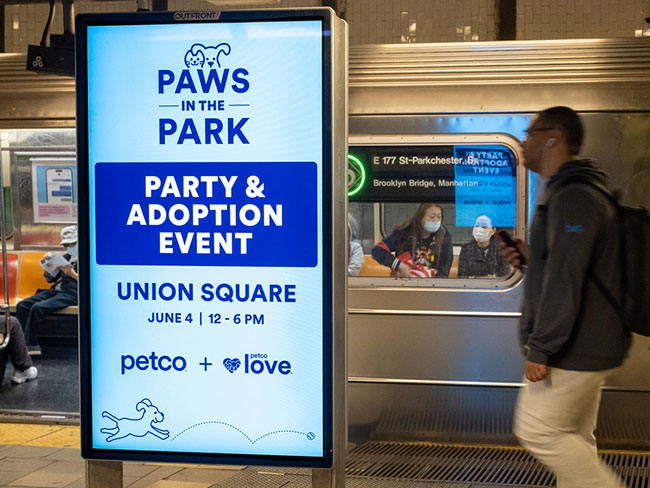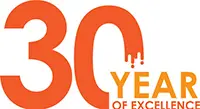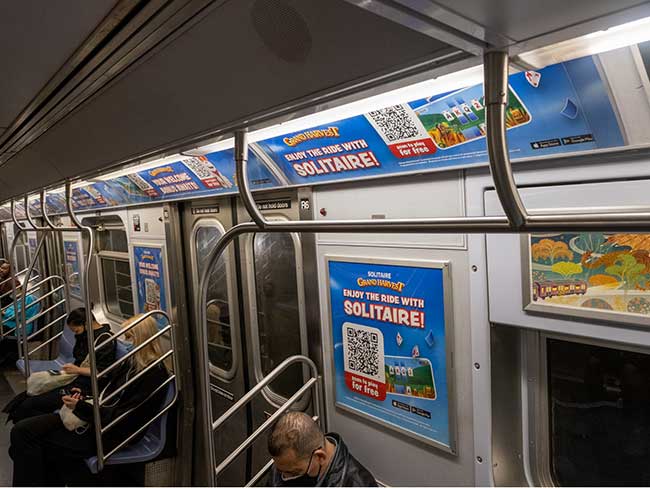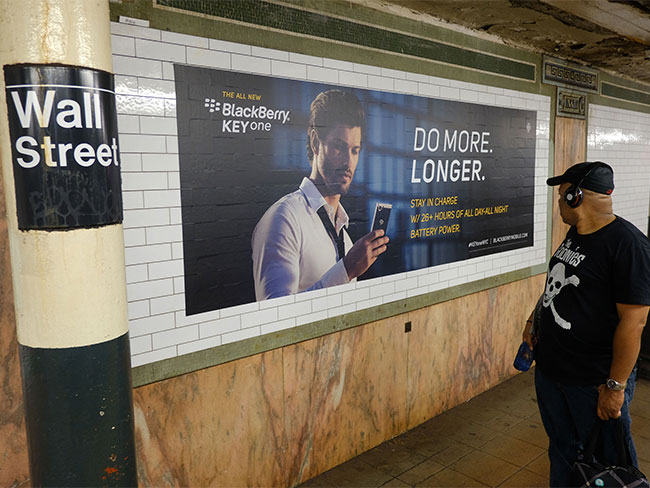Subway Advertising
What is Subway Advertising?
Subway advertising refers to the placement of promotional displays in various locations within subway systems. These displays can be found inside subway cars, throughout subway stations and platforms, at station entrances and exits, on station walls, clocks, ticket terminals, and other prominent areas in the subway environment.
Billboard Express specializes in subway advertising, offering a wide range of advertising options across different subway locations, including inside stations, on platforms, and within subway cars. They also provide advertising on urban panels, station walls, clocks, ticket terminals, and various other strategic spots within the subway system.
For a more immersive advertising experience, some subway stations offer station takeover advertising. This form of advertising allows a single advertiser to dominate the advertising space within a station. The cost for station takeover advertising varies significantly, ranging from tens to hundreds of thousands of dollars, depending on the location and duration of the campaign.
Overview of Subway Advertising Operators
Subway advertising operators specialize in managing and selling advertising space within subway systems. Here are a few specifics about their operations:
- Location and Placement: These operators provide a range of locations for advertising within the subway system, including inside trains, on platforms, in station halls, and at entrance or exit points. The placement of ads is strategically chosen to maximize visibility and impact among commuters.
- Types of Advertisements: They offer various types of ads, such as digital screens, posters, wraparound ads on trains, and floor decals. Some also provide options for immersive experiences like station takeovers, where all ads in a station are dedicated to a single advertiser.
- Technology Integration: Many subway advertising operators utilize advanced technologies, like digital or LED screens, which allow for dynamic content, including motion graphics and the ability to change ads remotely and quickly. This flexibility enables advertisers to update their campaigns in real-time and tailor messages to specific times of the day or events.
- Target Audience Reach: Subway ads have the advantage of reaching a diverse and broad audience. Millions of people use subways daily, offering advertisers significant exposure to various demographics, including working professionals, students, tourists, and local residents.
- Customization and Creative Services: Operators often provide customization options, allowing advertisers to create tailored campaigns that resonate with their target audience. Some also offer creative services to help design effective and eye-catching advertisements.
- Rate Structures and Packages: Advertising rates can vary based on factors like location, size of the ad, duration of the campaign, and the level of visibility. Operators usually offer different packages and pricing structures to accommodate various advertising budgets and campaign scales.
- Compliance and Regulations: Subway advertising operators must adhere to specific regulations and standards, ensuring that advertisements are appropriate for public spaces and do not violate any advertising laws or guidelines.
- Analytics and Reporting: Advanced operators may offer analytics and reporting services, providing advertisers with data on ad performance, viewer engagement, and campaign effectiveness. This data helps advertisers understand the impact of their campaigns and make informed decisions about future advertising strategies.
Example Campaigns:
Petco Advertised on Digital/LED Screens in Subway Stations

Petco utilized digital or LED screens located within subway stations for their advertising campaign. On these digital screens, advertising space is shared, with each advertiser allocated a specific “slot” that lasts for a set number of seconds intermittently, usually every minute. These advertisements can be either still/static images or include motion animation. Known as digital out-of-home advertising (DOOH), this format allows advertisers to vary their content, display video ads, and remotely update or change their creative material almost instantly.
Mobile App Publisher Playtika: Advertising on Subway Car Interiors in Metro Cities
Playtika, a mobile game app developer, launched an extensive advertising campaign for its “Grand Harvest” game by securing the interior advertising spaces of subway cars in major U.S. cities, including Chicago, New York City, and Los Angeles. In Chicago, every bit of the subway car’s interior advertising space was dedicated to Playtika’s game, while in New York City and Los Angeles, half of these spaces were utilized for the same purpose. The ads provided an immersive experience to commuters, presenting alternating creative messages about the game in a captive environment. The exclusivity of being the sole advertiser on one or both sides of a subway car significantly increased the visibility of these ads. This strategy of dominating the interior advertising space of subway cars is often termed as a “half brand” or “full brand” takeover.
Blackberry Advertising on Wall Street Station in Manhattan
For the launch of its latest smartphone, the KEYone, BlackBerry implemented a comprehensive subway advertising campaign at New York City’s Wall Street Station. In this station domination strategy, BlackBerry’s promotional material was featured in every advertising space throughout the entire station, ensuring maximum visibility and impact for the KEYone’s introduction.
How Much Does Subway Advertising Cost?
Top
General: For more specific pricing: Get Free Quote
Subway Advertising Rates
| Format | Rate |
|---|---|
| Backlit Diorama | Range of $500 – $2,150 per display per 4 week period |
| 2 Sheet | Range of $500 – $1,150 per display per 4 week period |
| Digital/LED/Video | Range of $600 – $975 per display per 4 week period |
| Interior Car Card (Vertical Format) | Range of $100 – $175 per display per 4 week period |
| Interior Car Card (Horizontal Format) | Range of $75 – $125 per display per 4 week period |
| Urban Panel | Range of $850 – $2,250 per display per 4 week period |
| Station Domination | Range of $20,000 – $70,000 or more per station per 4 week period |
Range of rates depends on timing and market.
Minimum Purchase:
Minimum purchase requirement is $6,500 per market or higher (depending on market), which may be spread over displays and periods. May be reduced in certain cases.
Discounts:
Government and nonprofit organizations may receive a discount on subway advertising.
Specs/Impressions
Range of impressions/views depends on market.
Contract Submission Deadline: Urgently, as advertising space is allocated based on a first-come, first-served approach.
Creative Due Dates:
- Static (Print): 2-3 weeks prior to ad start date. May be reduced in certain cases.
- Digital/LED/Video: 3 business days prior to ad start date.
| Format | Est. Impressions/Views |
|---|---|
| Backlit Diorama | Range of 2,500 to 12,500 per display per day. Size: 62″ W x 43″ H |
| 2 Sheet | Range of 1,500 to 10,000 per display per day. Size: 60″ W x 46″ |
| Digital/LED/Video | Range of 1,500 to 10,000 per display per day. Size: 1920px W x 1080px H |
| Interior Car Card (Vertical Format) | Range of 1,500 to 6,500 per display per day. Size: 21″ W x 22″ H |
| Interior Car Card (Horizontal Format) | Range of 1,500 to 6,500 per display per day. Size: 28″ W x 11″ H, 46″ W x 11″ H or 70″ W x 11″ H, depending on market |
| Urban Panel | Range of 5,000 to 20,000 per display per day. Size: 60″ W x 30″ H |
| Station Domination | Depends on Market Size: TBD |



